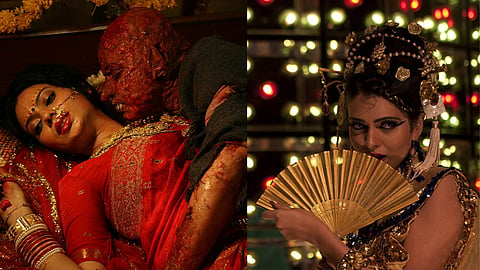
- HOMEGROWN WORLD
- #HGCREATORS
- #HGEXPLORE
- #HGVOICES
- #HGSHOP
- CAREERS
- ABOUT US
- CONTACT US

When we think of the film industry in India we think of Bollywood and its megastars. We think of blockbusters and box office hits that sometimes occupy the theatres for years for their stellar quality. But Bollywood is just a star-studded island in an ocean of the 2000 films made every year in this country. It's just a part of a larger cinematic ecosystem that is often overlooked.
Like C-grade films; the runt of the litter that is looked down upon by everyone. Even the most seasoned cinephiles that can find the art in sex, blood and gore in 5-hour long East-European films somehow lose their respect when it comes to the Indian C-grade film Industry. Although these films aren't usually taken seriously and are viewed as low budget, poor publicity, lecherous, dark, and cheap entertainment, over the years many filmmakers from In and outside India have been drawn into the sleazy world of C-grade Indian cinema.
Ashim Ahluwalia, the director of the new series, Class on Netflix himself has spent 10 years researching this industry. His debut fiction feature was a film called Miss Lovely starring Nawazuddin Siddiqui about the porn-horror fringe-filmmaking in a 1980's Mumbai. Miss Lovely had its premiere at the 2012 Cannes Film Festival and even won two National Awards.
The plot of the film explores the intense and mutually destructive relationship between younger sibling Sonu Duggal, and his elder brother, Vicky who produce sleazy sex-horror films in the mid-1980s. Sonu finds himself drawn to a mysterious young woman named Pinky and sets on a journey to to break away from his controlling brother and direct a feature of his own which eventually leads to his downfall.
The director created this film as his tribute to the horror genre inspired by the Ramsays which he confesses "...is unfortunately dying." He says, "C-Grade films are more honest and are characterised by violent, gory, and mostly sexual content and a minimum of artistic interest. They are not even trying to mimic A-Grade films and often have something unintentionally interesting going on."
The Ramsays or Ramsay brothers, originally seven brothers, emerged in the 70s and 80s as India’s leading exponents of horror. They were mainstream and had built a reputation as good filmmakers in the genre they were operating in. A lot of filmmakers in the 80s and 90s took the horror formula from their films and mixed it with erotica to create the signature style of Indian C-grade movies.
Ashim talks about the C grade film industry, "Because of their limited resources, they take only fours days to make a film, which is the time Bollywood spends on making an item song." And the players in the industry have a rebellious streak in them. "They laugh at Bollywood. They are comfortable in their space and would rather be at the top of their game here than be strugglers in Bollywood."
However as the digital age arrived, the industry ceased to exist, "I started my research at a time when everything was falling apart. A bulk of the industry survived because of the sex reels, as at that time people did not have easy access to pornography. Those who wanted to see naked bodies, sex and violence had to go for such movies. But now porn is available online,” says Ashim.
Creative Writer, Aseem Chandaver, a devoted fan of India's C-grade industry breaks down why it couldn't quite rise to fame, “Part of the problem is that we don’t have cerebral filmmakers who make lowbrow films on purpose. That’s why scholars don’t show any interest in Indian C-makers. On the other hand, someone like Corman (Roger Corman, AKA 'The King of Cult') is informed on the overall history of cinema and is allied with mainstream Hollywood. In the West, Tarantino has a cinematic sensibility held in respect, and this is a filmmaker who reputedly spoke of rummaging through the history of B-movie bins to find ‘jewels’. What our C-movies lack is that sophisticated sensibility.”
Indian C-movies bear all the hallmarks of indie cinema, but seem destined to remain in the shadows with the biggest debate surrounding them being the grades we give them. A new series on Prime Video called Cinema Marte Dum Tak discusses how the B or C grades were only supposed to highlight the budget of these films and not their value. If we could, perhaps, lend the industry the same courtesy that Tarantino and other directors do to pulp fiction films, maybe, with the help of willing filmmakers, C-grade films could rise up to cult status in their portrayal of the basest human nature.
